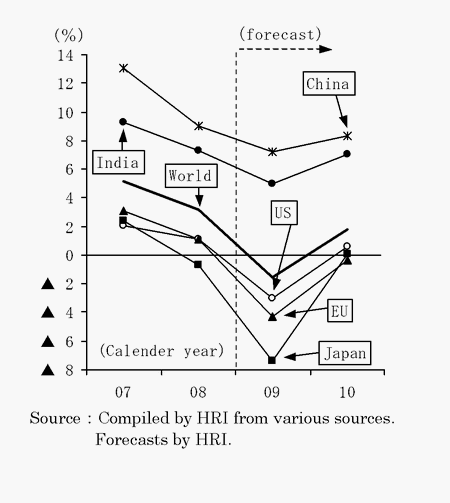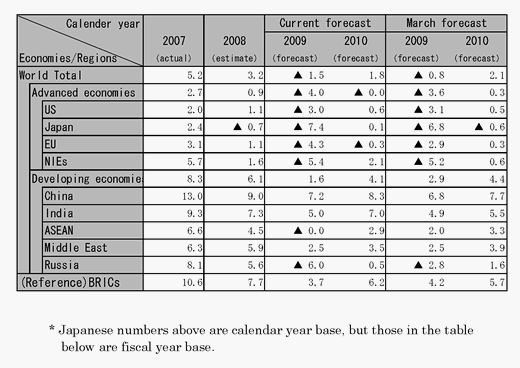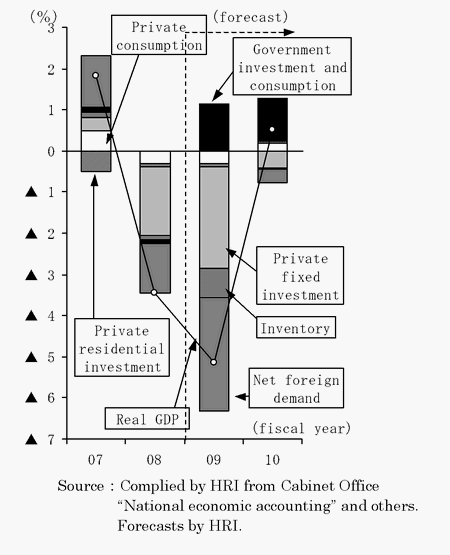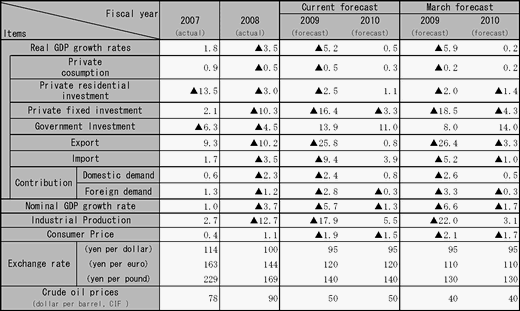Latest economic forecasts for Japan, the U.S., Europe, and China, etc
World economy passed through steep fall phase, which was felt like a severe storm, in 2009 1Q. The inventory adjustment finally caught up with the steep fall of demand. In the G20 London summit in April 2009, each country came out with financial and fiscal policy in harmony. Then excessive pessimism in financial market retreated. The market expectation that the economy would go into recovery phase got high, and the stock prices began to rise from the bottom of February 2009. But is it real? We doubt it. Our current forecast is almost same as the last one. We forecast that economic recovery will be L shaped and very gradual, and that manufacturers will be forced to endure 70% capacity utilization rate. That is to say, we forecast that the road to recover is long, troublesome and full of ups and downs. There is even some possibility that the economy will go down to the second bottom. Since the economy will not recover to the pre-Lehman shock level soon, but certainly passed through the steepest fall phase, we say that the economy is now in "the stabilizing phase."
The steep economic decline left deep scars. In the US, the pace of employment loss is slowing, but the accumulated number of lost employment from October 2007 to April 2009 reached 6.43 million. The housing prices have not yet stopped falling down, and the households’ excessive debts are far from normal level. It is too early to judge that financial institutions got out of the worst mess of disposal of toxic assets. Therefore, the US economy will continue to shrink for a few more quarters. The US real GDP growth rates are expected to contract by 3.0% in 2009 and grow 0.6% in 2010. Compared to the US banks, the European banks are significantly slow in making progress in disposing of toxic assets. And Germany experienced as much economic shrinkage as Japan did, due to sudden fall of export within the EU area. The real GDP growth rates in the whole EU 27 countries are expected to contract by 4.3% in 2009 and grow 0.3% in 2010. On the other hand, China and India will keep high growth rates of 5% to 7%, though slowed down significantly from 2008. The world economy is expected to contract by 1.5% in 2009, grow by 1.8% in 2010. The positive growth of the developing economies, such as China and India with 2.4 billion people, will make up for the negative growth of developed economies with one billion people.
Japanese economy is in the stabilizing phase. Japanese manufacturers still face 70% capacity utilization rate. We expect the production will recover to the level which is aligned with the proper inventory level, but an increase in demand thereafter is in doubt. Though foreign demand may pick up in the markets of developing countries, domestic demand is expected to continue shrinking. Investment in plant and equipment will shrink, due to low corporate profits and capacity utilization rates. Furthermore, employment adjustment will get serious, and wages and bonuses are to be cut. This leads to a decrease in private income, which will be much larger than the Supplementary Income Payments that transfer 2 trillion yen from government to households. Private consumption will decrease as a matter of course. It remains to be seen whether the government’s economic stimulus measure, 15.4 trillion yen, is large enough to support the economy throughout the secound half of FY 2009. Though Japanese economy passed through the steepest decline phase, it will not start to recover. Weak domestic demand may force inventory adjustment again. Japanese economy is expected to remain low level throughout FY 2009, and face long stabilizing phase full of ups and downs. In the second half of FY 2010, finally economic recovery will be felt. The Japanese real GDP growth rates are expected to contract by 5.2% in FY 2009 and grow 0.5% in FY 2010. Foreign exchange rates are assumed to be 95 yen/ dollar, 120 yen/euro, and the oil price is 50 dollars/ barrel in FY 2009.
While each country came out with large-scale economic stimulus packages, large-scale infrastructure investment deserves our attention. This large investment can be done only in this depression period. This is so called "contest of smart fiscal expenditure." Let’s say that the themes in the Great Depression in 1930’s were "freeway network" and "electricity network." This time we can say the main theme is "green revolution." In this way, social foundations of next generations will be created, and economic growth in the future will depend on them. If we pick up the projects which are related to the Hitachi group’s businesses from Japanese and the US economic stimulus packages, the total amounts of those projects are 5 trillion yen in Japan, 26 trillion yen in the US respectively.
Technological innovation is occurring in the worldwide depression, and the biggest business chance is about to be created.



